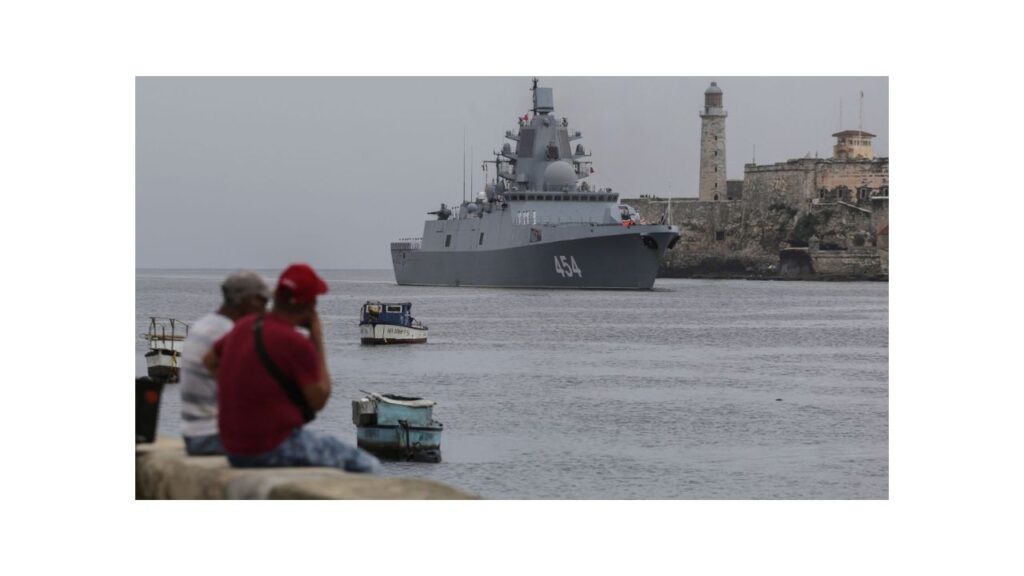On Wednesday, a fleet of Russian warships entered Cuban territorial waters in advance of scheduled military drills in the Caribbean, which some perceive as a show of force as hostilities over Western backing for Ukraine escalate.
Following exercises in the Atlantic Ocean, the fleet—which included a frigate, a nuclear-powered submarine, an oil tanker, and a rescue tug—entered Havana Bay. There was a 21-cannon salute to the flagship frigate, which was flying the Cuban and Russian colors.
As they neared the island, the Russian sailors on board the ship formed a military formation. A few locals in Cuba paused to snap photos of the approaching ships.
Officials from the United States anticipate that the Russian ships will stay in the area all summer and may even make a stop in Venezuela.
Russia has been a longstanding supporter of Cuba and Venezuela, and its planes and warships have occasionally ventured into the Caribbean. However, President Vladimir Putin hinted that his military might retaliate with “asymmetrical steps” elsewhere in the world in response to President Joe Biden’s approval for Ukraine to use American-supplied weapons to strike inside Russia to defend Kharkiv, the country’s second-largest city. This mission was approved less than two weeks ago.
Regarding the West’s engagement in Russia’s war in Ukraine, Benjamin Gedan, director of the Latin America Program at the Wilson Center think tank in Washington, stated, “most of all, the warships are a reminder to Washington that it is unpleasant when an adversary meddles in your near abroad.”
He said, “It also serves as a reminder to Russia’s allies in the region—including the United States’ adversaries, Cuba and Venezuela—that Moscow is on their side.”
A senior U.S. administration official told The Associated Press that although the fleet includes a nuclear-powered submarine, the intelligence community has concluded that no vessel is transporting nuclear weapons. The person added that Russia’s deployments “pose no direct threat to the United States,” speaking under condition of anonymity in order to provide information that had not been made public.
Since 2008, when a flotilla of Russian ships entered Cuban waters in what state media reported as the first such visit in nearly two decades, Russian ships have periodically docked in Havana. One day prior to the commencement of negotiations between American and Cuban authorities over the restoration of diplomatic ties, a communications and reconnaissance ship unexpectedly docked in Havana in 2015.
Russia’s port calls in Cuba are “routine naval visits,” a State Department spokeswoman told the AP, adding that the country’s military drills “have ratcheted up because of U.S. support to Ukraine and exercise activity in support of our NATO allies.”
Bruno Rodríguez, the foreign minister of Cuba, was received by Sergey Lavrov, the Russian foreign minister, for negotiations in Moscow on Wednesday. After the meeting, Lavrov commended the Cuban government for their stance on Ukraine in an interview with media.
“Havana provided an assessment of the situation from the start, stating the absolutely true and accurate reasons for what was happening (in Ukraine) and what the West was preparing for years,” Lavrov stated.
According to Ryan Berg, director of the Americas Program at the Center for Strategic and International Studies in Washington, D.C., Russian military and defense doctrine places Latin America and the Caribbean in a key position, with the region perceived as being under American influence serving as a counterbalance to Washington’s actions in Europe.
Berg stated, “Although this is probably just Moscow’s way of provoking trouble, it communicates a message about Russia’s capacity to project power into the Western Hemisphere with the support of its allies and will undoubtedly keep the U.S. military on high alert while they are in theater.”
Russia may benefit from this year’s mission’s timing, but it also raises concerns about whether Venezuela’s government would use it to support President Nicolás Maduro’s campaign for a third term on July 28.
The main opposition alliance in Venezuela is posing a challenge to the governing party’s thirty-year hold on power, and experts predict that Maduro’s administration may try to postpone or cancel the election by creating a crisis based on smoldering tensions with Guyana.
According to U.S. Army War College research professor Evan Ellis, “it is almost unthinkable that Maduro will risk actually losing power.”
“The most obvious alternative is to fabricate an international crisis that would provide an excuse for ‘postponing’ Venezuela’s election, consistent with the recent moves of the Venezuelan military,” he said. “It’s possible that Maduro is trying to create a crisis, and the presence of Russian warships nearby would significantly increase the risk of an escalation.”
A referendum to assert sovereignty over the Essequibo territory—which makes up two thirds of Guyana and is located close to significant offshore oil deposits—was passed by Venezuelan voters in December. Venezuela claims that when the border was established more than a century ago, it was stolen.
Guyana is waiting on the International Court of Justice to rule on Venezuela’s claim, but Maduro’s administration does not acknowledge its legitimacy. On Tuesday, the two nations faced off there, with Guyana vehemently opposing to Venezuela’s request for an extra year to make more appeals.
When Venezuela threatened to invade Guyana late last year, the United States helped the country by providing surveillance planes and has since supported Guyana in the current conflict. In a show of strong collaboration, Guyana’s government allowed the US military to fly two formidable F/A-18F Super Hornet jets over the nation’s capital last month.
On June 6, Bharrat Jagdeo, the vice president of Guyana, stated that the Russian navy is not “a direct threat.”
“Nevertheless, we’re vigilant, and we’re keeping this issue firmly in our policy radar,” Jagdeo said in a press conference.
